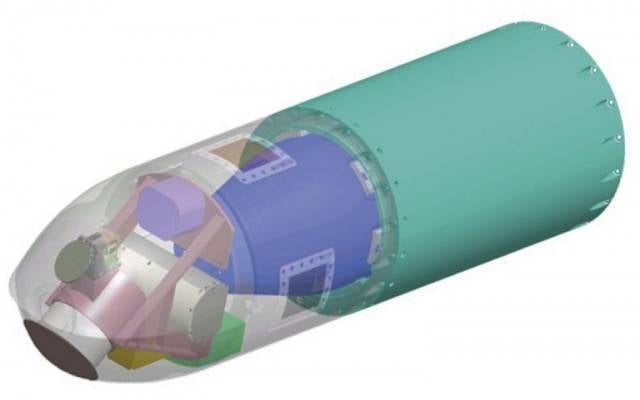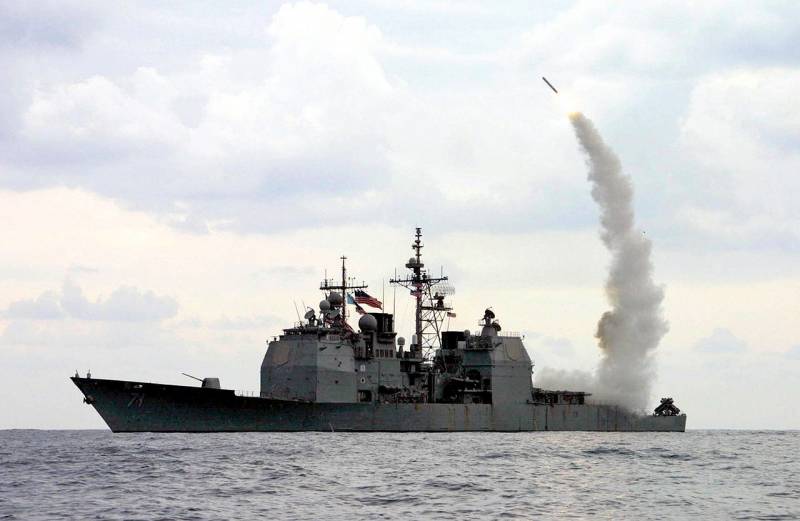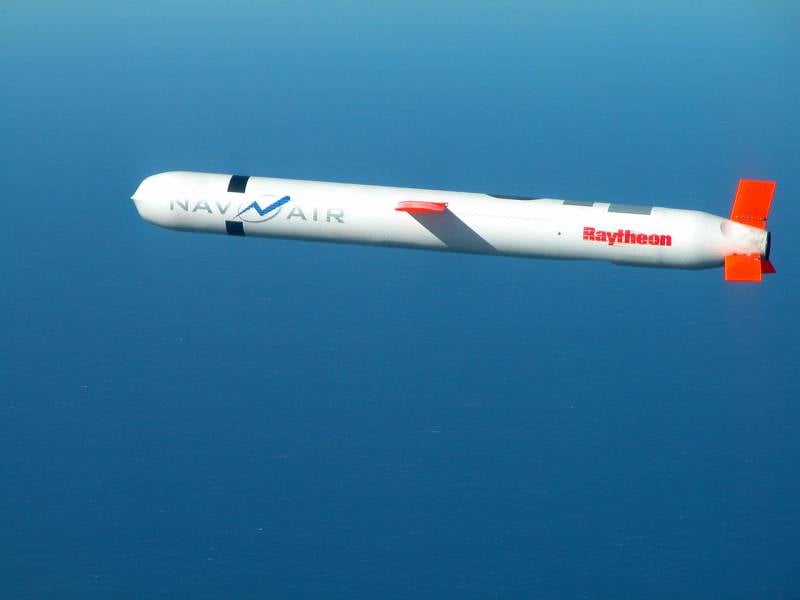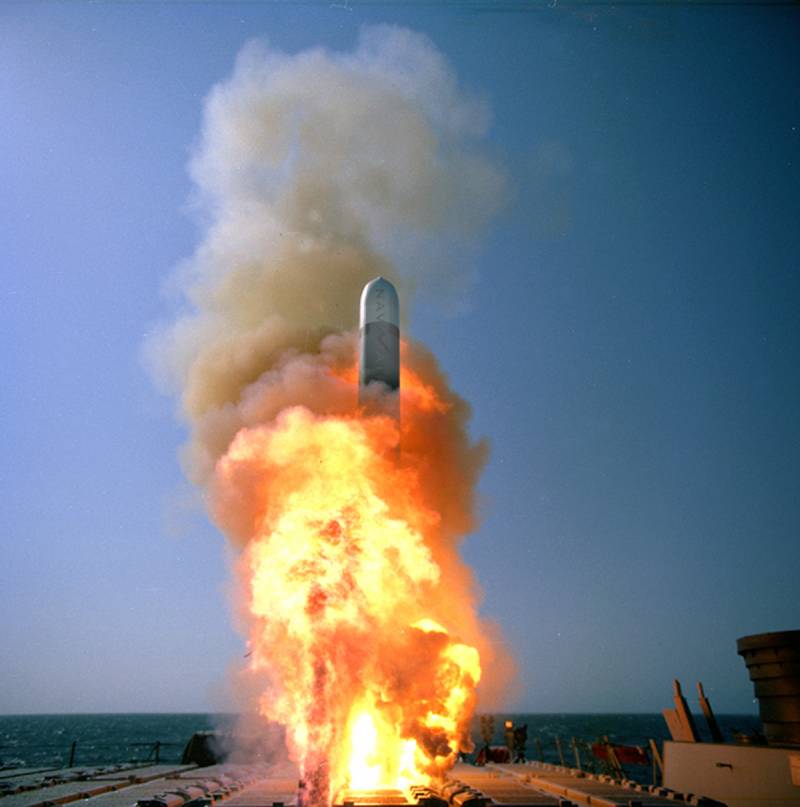Tomahawk Block IV cruise missile: new features of old weapons
At the moment, the newest version of the Tomahawk rocket is a modification of Block III, created and put into service in the early nineties. The project Tomahawk Block III implied performance enhancement weapons through the use of an updated guidance system that determines its own coordinates by GPS signals, and an improved power plant. As a result, such a rocket could fly farther than its predecessors and more accurately hit these targets. However, over time, the modification of Block III has ceased to fully meet the requirements of the military. As a result, a new project was launched, the goal of which was again to increase the basic technical and combat characteristics.
The beginning of the development of the Tomahawk Block IV project was announced at the beginning of the last decade. The official reports of the US military and some defense industry enterprises revealed the main features of future modernization and the general requirements for the renewed rocket. As it soon became clear to their number of new messages, it was proposed to improve existing weapons through the use of new components, as well as through the use of other algorithms of work. All this made it possible to obtain a number of new opportunities with clear consequences for the combat effectiveness of the rocket.
Previous versions of Tomahawk missiles can only be aimed at one target. In the Block IV project, the customer required to ensure that the coordinates of 15 objects of the enemy were simultaneously introduced into the homing head. In this case, it was necessary to provide for the redirection of the rocket during the flight. In addition, for the full realization of all the benefits of such an update, the rocket should have been able to barrage in a given area in anticipation of new operator commands.
The existing control system using inertial and satellite navigation was proposed to be supplemented with new means. In the instrument compartment of the rocket, it was necessary to install optical / thermal imaging surveillance equipment and a video signal transmission system. With the help of this equipment, the operator of the complex could monitor the flight of the rocket and, if necessary, control it. Video transmission and telemetry could also be used to conduct intelligence and monitor the results of previous launches. Communication between the rocket and the operator’s console was to be via satellite.
As part of the modernization program should improve the equipment designed for ships and submarines carriers of rocket weapons. Now the operator of the complex should have been able to fully plan the so-called. GPS missions - firing rockets using only the coordinates of the target, but not the full amount of data used previously. Also, the carriers were to receive control equipment such as Tomahawk Weapons Control System and Tomahawk Command and Control System.
The initial draft of Tomahawk provided for the possibility of using conventional and special combat units. The use of nuclear weapons in the future refused. In addition, by the time the Block IV project began, the existing high-explosive warhead had ceased to organize the military. As a consequence, the JMEWS (Joint Multi-Effects Warhead System) project was launched. The result of this project was to be a new combat unit, characterized by high penetration characteristics, but at the same time maintaining the high-explosive and fragmentation effect at the level of the previous product.
The result of the next modernization program was to be the emergence of an improved cruise missile, which differs from its predecessors in enhanced performance and enhanced combat capabilities. It was expected that after such an update, the Tomahawk Block IV product would be able to attack ground and surface targets, both stationary and moving. By using the new JMEWS warhead, it was possible to ensure the destruction of protected ground objects, such as slightly buried bunkers, etc. At the same time, a new warhead, at a minimum, should not have been inferior to existing products.
From a certain time, the improved "Tomahawk" began to be considered as a possible alternative to the existing Harpoon anti-ship missiles. With noticeable advantages in all the basic characteristics, the Tomahawk Block IV anti-ship variant could replace the smaller and heavier production model missiles. This would give advantages both combat and operational nature. First of all, carriers of rocket weapons would no longer need to be equipped with launchers of various types.
It should be noted that along with the increase in technical and combat characteristics, the use of new components should have given certain possibilities that were absent from previous missiles of the family. The most noticeable advantage of Tomahawk Block IV should have been a drastic reduction in preparation time for launch. The mission planning, rocket preparation and other operations previously required 80 hours. In the new project, all these operations require no more than an hour, after which the rocket can be sent to the target. At the cost of some reduction in the combat radius, a certain fuel economy is achieved, allowing the rocket to remain in the target area and wait for the attack command.
The development of a promising version of the cruise missile was entrusted to the Raytheon company, which had previously created the previous products of the family and was engaged in the production of serial weapons. Over the next few years, the bulk News about the Tomahawk Block IV project concerned the signing of various contracts and agreements. In addition, during this period, the customer and contractor repeatedly reviewed various features of a promising project. Nevertheless, the US military and industry several times talked about successes of a technical nature.
In 2004, the new rocket was officially put into service, but the development of the project did not stop. In 2006, it was announced to continue the upgrade, which is still ongoing. At this stage, it was necessary to renew the composition of the onboard equipment of the rocket and improve its main characteristics. Also, it was in the framework of the second stage of modernization that it was planned to implement some of the functions. It was decided not to use a new designation for the updated project.
So, in August 2010, the specialists of the naval forces and defense industry conducted the first successful test of the JMEWS warhead. Subsequently, such tests were repeated several times, after which the design of the product began to be adapted to be installed on Tomahawk missiles. According to reports, to date, such work has been completed.
In October, 2013, the company Raytheon announced the successful testing of the updated guidance system. In preparation for these tests, the homing systems were improved with the latest radar head. In addition, the test complex of onboard equipment has already managed to get two-way communication with the operator’s console and some other innovations. The development company claimed that the latest improvements will effectively use a cruise missile as an anti-ship weapon.

Scheme of the head compartment of the Block IV rocket containing the guidance tools and the warhead. Figure Raytheon / raytheon.com
19 February 2014, the first full-fledged test launch of a Tomahawk Block IV cruise missile, finalized on an actual project, took place. As it was reported, before the launch, the coordinates of the target and the flight program describing the entire route to it were entered into the memory of the rocket. Throughout the test flight, the prototype rocket maintained two-way communication with the operator’s console. In order to test and evaluate new capabilities during the flight, the rocket received updated target designation data. Automatics correctly processed the commands and ensured the defeat of the conditional goal. Communication with the carrier was maintained until the moment of hitting the target.
At the same time it was reported that in the foreseeable future, testing of missiles with a new complete set will continue. The Pentagon and the company Raytheon planned to test the work of the new on-board automation in various modes and under different conditions. In particular, experiments were planned with the implementation of the connection between the rocket and the console using separate repeater planes.
In the spring of 2014, the US military began the work on determining the required volume of purchases of new weapons. During 2014-15, it was proposed to purchase about three hundred Tomahawk missiles. In the future, the armed forces could expect to receive similar products of the latest modification. In total, the command wants to simultaneously be armed with about 4 thousand Tomahawk missiles of all modifications. Such a number of such weapons will quickly and correctly respond to all possible threats. The proportion of missiles of the last modification will have to gradually grow.
In September of the same year, Raytheon announced the launch of two new tests of Tomahawk Block IV missiles using naval-supplied carriers. One of the new type advanced missiles was launched by the USS Hampton nuclear submarine (SSN-767), and the second was sent to the target by the USS Lake Champlain missile cruiser (CG-57). Again increased flight performance and product specifications were confirmed. In addition, experienced rockets again demonstrated the ability to quickly and easily retarget after launch.
In the summer and autumn of 2015, the development company conducted several tests, during which an experienced new model rocket demonstrated for the first time in practice its capabilities in conducting reconnaissance using onboard optical-electronic systems. The prototype rocket was launched from one area and headed to the second. There, the operator made the necessary observations, and then sent a rocket into the third zone. In the latter there was a conditional target that the rocket was supposed to hit. Also, during such tests, it was found that such original methods of using missiles can be used both for single and salvo launches.
Tests were scheduled for the 2015-16 winter, in which Tomahawk Block IV missiles were to hit moving ground and surface targets. To defeat moving objects missiles must use new elements, relatively recently introduced into the composition of the homing equipment. With some problems of a technical or other nature, experienced rockets, in general, successfully coped with the tasks assigned to them.

Launch of the upgraded "Tomahawk" from the cruiser USS Cape St. George (CG-71), 23 March 2003. Photo Navsource.org
At the beginning of 2016, it was announced the start of work on finding new ways to improve the combat qualities of the rocket. Experts from the laboratory of Energetic Materials Research and Engineering proposed to increase the impact of the standard warhead with the help of some improvements in the fuel system. In some situations at the time of hitting the target in the missile tanks may be some amount of fuel. Scientists of the laboratory were able to use a tank with fuel residues as a specific ammunition for a volumetric explosion. With the help of special means of spraying and ignition, it was planned to obtain an optimal distribution of fuel in the surrounding volume with its subsequent ignition. In case of successful solution of the existing tasks, prospective modifications of the missiles will have to be distinguished by increased power while maintaining a regular warhead.
11 January 2017, the company Raytheon has completed the successful completion of tests of the latest rocket Tomahawk Block IV. The tests ended with two launches of missiles from the ship USS Pinckney (DDG-91), which was located on the sea range off the coast of California. The first test firing of the rocket meant the quickest possible preparation for launch, after which the weapon went to the intended target, following the program laid down. The second test launch was carried out without a previously prepared program and with a missile control during the flight. These tests reaffirmed the fundamental possibility of the practical application of new functions for solving various combat missions.
In previous versions, the Tomahawk cruise missile was a guided weapon suitable for engaging stationary land targets. Previously, rockets could follow the originally laid down program and follow the target along the specified route. Such features of the complex provide an acceptable probability of hitting targets, however, they no longer fully meet the requirements of the times and the wishes of the main operator, represented by the US Navy. Based on the desire to increase the potential of surface and submarine forces, upgrade their arsenals and gain new capabilities, the US Navy previously initiated the creation of a new modification of the existing missile.
For the development of missile weapons, it was decided to use new approaches. According to available information, the Tomahawks are now being upgraded by replacing or processing all the main rocket units. Without significant changes, only the glider remains. Thus, quite old rocket weapons are now being developed on modular principles. This allows introducing new elements and equipment with the required capabilities into the design. Such approaches have already shown their potential, having confirmed it in the course of numerous lengthy trials.
The current modernization of cruise missiles, which allows to solve various combat missions and destroy various enemy targets, will allow the US military to keep Tomahawk products in their arsenals for the next few decades. It is known that at the end of the current decade, the program of repair and renewal of the remaining models of rockets will have to start. After the restoration of technical readiness and the installation of new components, these weapons will meet modern requirements and will be able to remain in service in the future. In parallel with this, the production of new missiles, which initially have new capabilities, will continue.
Over the past few decades, the United States naval forces have repeatedly taken part in armed conflicts, in the course of which they used Tomahawk cruise missiles. Over the entire period of operation of such weapons, a total of more than 2 thousand guided missiles were used, the targets of which were various ground targets of the enemy. The current modernization of such weapons directly speaks of the desire of the American command to keep it in service, but at the same time receive new opportunities associated with the modernization of the onboard systems. This means that the Tomahawk Block IV missiles will remain in service for a long time, and are likely to be able repeatedly to take part not only in exercises, but also in real combat operations. It is in the setting of a real war that a modernized weapon will be able to show its capabilities.
On the materials of the sites:
http://raytheon.com/
http://defenseindustrydaily.com/
http://nationalinterest.org/
http://militaryaerospace.com/
http://breakingdefense.com/


Information